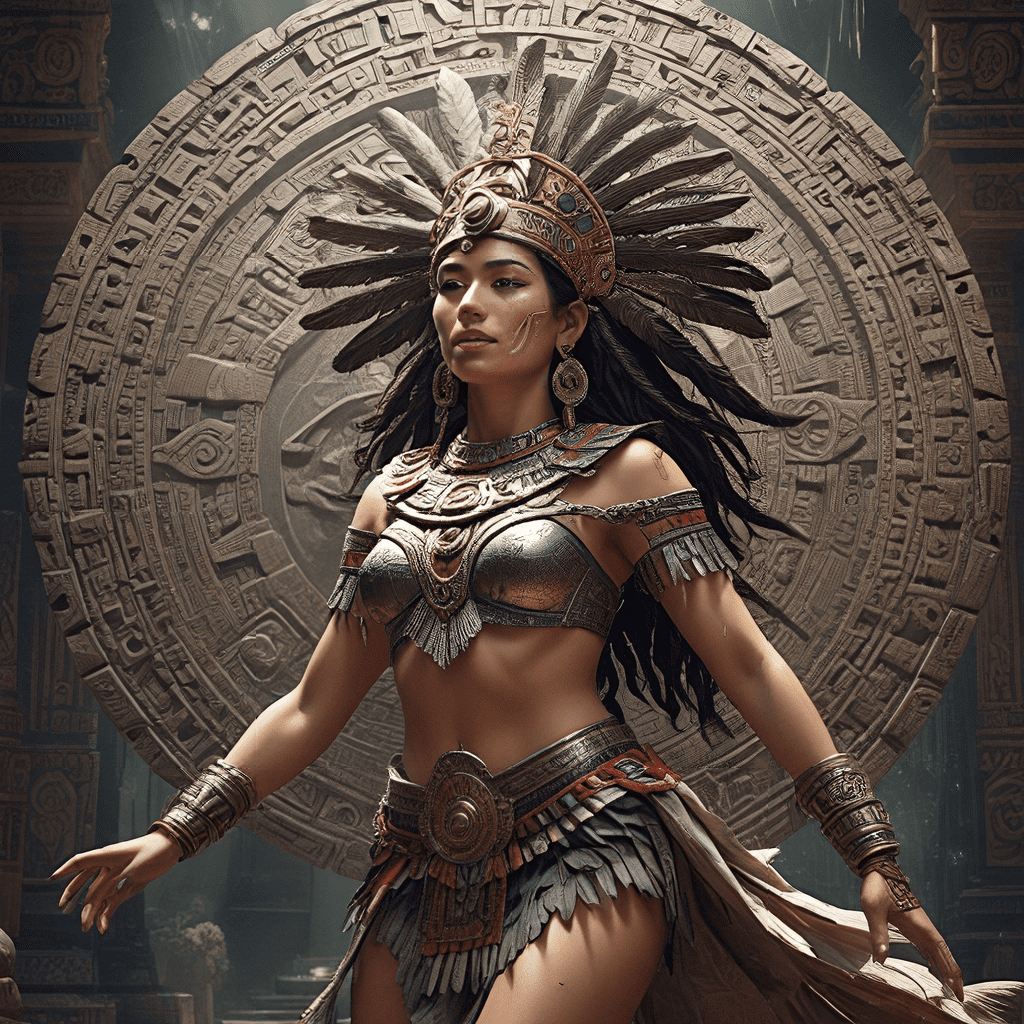The Moon in Aztec Cosmology
The moon, a celestial body that has captivated humans for centuries, held a significant place in the cosmology of the Aztecs, an ancient civilization that flourished in Mesoamerica. The Aztecs, known for their intricate understanding of the cosmos, believed that the moon, like the sun, played a vital role in the balance and order of the universe. They saw the moon as a celestial being, a powerful deity who influenced daily life, agricultural cycles, and even the human soul. This celestial body was not merely a passive observer but an active participant in the cosmic drama, a divine entity that commanded respect and reverence.
Metztli: The Goddess of the Moon
In Aztec mythology, the moon goddess, known as Metztli, was a prominent figure. She was not simply a representation of the moon itself; she embodied its essence, its power, and its influence. Metztli was revered as a powerful deity, a divine being who held sway over the night, the tides, and the cycles of nature. She was depicted as a beautiful woman, often adorned with a crescent moon on her head or breast, signifying her connection to the celestial body she represented.
Metztli’s Attributes and Symbolism
Metztli was associated with a range of attributes and symbols that reflected her multifaceted nature. She was often depicted in art and literature wearing a rabbit on her back, symbolizing fertility and the connection to the animal world. The rabbit, known for its prolific breeding, represented Metztli's role as a fertility goddess. Additionally, the moon goddess was frequently linked to water, symbolizing her influence on the tides and her association with the life-giving element. Her connection to water was also reflected in her association with the underworld, a realm believed to be ruled by the goddess of water, Chalchiuhtlicue.
Metztli’s Role in the Aztec Calendar
The Aztec calendar, a complex system that incorporated both solar and lunar cycles, held a special place for Metztli. The lunar calendar, a 260-day calendar known as the Tonalpohualli, was based on the lunar cycle. Metztli's lunar cycle and the calendar were intricately linked, and her phases were seen as a reflection of the cyclical nature of life and death. The Aztec believed that each lunar phase carried its own unique significance, influencing human events and the natural world.
Metztli’s Association with Fertility and Water
Metztli was not only a lunar deity but also a fertility goddess. Her association with the rabbit, a symbol of prolific breeding, emphasized her role in fostering life and growth. The moon's influence on the tides, a natural phenomenon that plays a significant role in marine life, further solidified Metztli's connection to fertility and water. This association made her a powerful deity for women seeking fertility and for farmers hoping for bountiful harvests.
Metztli’s Relationship with the Sun God Tonatiuh
In Aztec mythology, Metztli's relationship with Tonatiuh, the sun god, was a complex dynamic, reflecting the celestial dance between the sun and moon. They were seen as complementary forces, representing the duality of light and dark, day and night. Though distinct in their powers, they worked in harmony to maintain balance in the cosmos. This partnership was reflected in the Aztec calendar, where the lunar cycle of Metztli interacted with the solar cycle of Tonatiuh.
Metztli’s association with the night, a time of rest and dreams, contrasted with Tonatiuh’s association with the day, a time for activity and work. This contrast reinforced their roles as complimentary forces. Metztli provided a respite from the sun's harsh glare, while Tonatiuh provided the energy for life to flourish.
Their relationship was not always harmonious, however. Aztec mythology portrays a tension between the two deities. This tension symbolized the natural conflict between light and darkness, day and night. This rivalry was a symbolic representation of the constant push and pull of opposing forces in the universe, a struggle that was essential for maintaining order and balance.
Metztli’s Connection to the Underworld
In Aztec mythology, the underworld, known as Mictlan, played a significant role. Metztli's connection to the underworld was established through her association with water and her role in the lunar cycle. Water was seen as a conduit between the world of the living and the world of the dead. Just as the moon’s phases reflected the ebb and flow of life and death, the underworld was believed to be a place of transformation, where souls journeyed after death.
Metztli's role in the lunar cycle was also tied to her connection to the underworld. The moon’s phases, from its waxing to waning and back again, were seen as a metaphor for the cyclical journey of the soul through life and death. The dark moon, invisible in the night sky, represented the descent into the underworld, while the waxing moon symbolized the journey back to life.
Metztli’s association with the underworld was not one of fear or darkness. Instead, she was seen as a guide, a protector of the souls in their journey across the threshold of death. Her presence in the underworld offered comfort and reassurance, a symbol of hope for those who had passed on.
Metztli in Aztec Mythology and Ritual
Metztli's presence in Aztec mythology was widespread, reflecting her significant influence on their lives. She was a central figure in their stories, their rituals, and their understanding of the world. Her connection to fertility, water, and the lunar cycle made her relevant to a wide range of aspects of their lives, from agriculture and fishing to healing and rituals. In Aztec art, Metztli was often depicted in beautiful ceramic figures and intricate murals, showcasing her important role in their culture.
Metztli was also a central figure in Aztec rituals. Offerings were made to her, often involving rabbits, water, and other symbols associated with her. These offerings were a way to appease the goddess, seeking her blessings for fertility, bountiful harvests, and protection from harm. The lunar phases were also incorporated into Aztec rituals, with specific ceremonies held during certain stages of the moon’s cycle.
Metztli's influence on Aztec mythology and ritual highlights her importance in their culture. She was more than just a goddess of the moon; she was a powerful symbol of the cyclical nature of life, a force that influenced every aspect of their existence.
The Evolution of Metztli’s Myth
Throughout Aztec history, the myth of Metztli evolved and transformed, reflecting the changing needs and beliefs of the people. As the Aztec civilization flourished and expanded, so too did the complexity of their mythology. The influence of other Mesoamerican cultures, with their own rich traditions, also contributed to the evolution of Metztli’s myth.
Over time, new aspects of Metztli’s personality and attributes were incorporated into her legend. Her association with various deities, such as Chalchiuhtlicue, the goddess of water, and Xochiquetzal, the goddess of love, added further dimensions to her story.
This evolution of Metztli’s myth demonstrates the dynamic nature of ancient beliefs. It reflects how mythology adapts to the changing needs and experiences of a culture, while still preserving the core elements of its essence.
Theories on the Origins of Metztli’s Myth
The origins of Metztli’s myth remain a subject of debate among scholars. There are various theories surrounding the origins of this powerful lunar deity.
One theory suggests that Metztli’s myth evolved from earlier Mesoamerican traditions. The worship of lunar deities was common across ancient Mesoamerica, suggesting that Metztli’s story might have roots in these earlier traditions.
Another theory proposes that Metztli’s myth developed from the Aztecs’ close observation of the natural world. The moon’s influence on the tides, the agricultural cycle, and human emotions would have been a source of fascination and inspiration for the Aztecs.
Regardless of its specific origins, the myth of Metztli reflects the human fascination with celestial bodies. It captures the enduring power of the moon to inspire wonder, awe, and reverence.
FAQ
What is the significance of the rabbit in Metztli's symbolism?
The rabbit, known for its prolific breeding, symbolizes fertility and the connection to the animal world. It represents Metztli's role as a fertility goddess, associated with life, growth, and abundance.
How did Metztli's role in the Aztec calendar influence their understanding of time and the universe?
The Aztec calendar, incorporating both solar and lunar cycles, reflected the influence of both Tonatiuh and Metztli. Metztli's lunar cycle, the foundation of the 260-day Tonalpohualli, highlighted the cyclical nature of life, death, and rebirth. It created a framework for understanding the universe as an interconnected system of cycles.
What is the connection between Metztli and the underworld, Mictlan?
Metztli's connection to the underworld is through her association with water, a conduit between the world of the living and the dead. Additionally, her role in the moon’s phases, symbolizing the cyclical journey of the soul through life and death, reinforces this link. She is seen as a guide for souls in their journey across the threshold of death.
How did Metztli's myth evolve over time?
Metztli's myth, like many ancient myths, evolved over time, reflecting the changing needs and beliefs of the Aztec culture. The influence of other Mesoamerican cultures and the incorporation of new aspects of her personality contributed to this evolution, leading to a more complex and multifaceted narrative.
What are some theories about the origins of Metztli's myth?
Scholars theorize that Metztli’s myth evolved from earlier Mesoamerican traditions, stemming from the ancient worship of lunar deities prevalent in the region. Another theory suggests that her myth arose from the Aztecs' deep observations of the moon's influence on the world.


